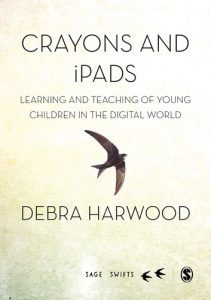
In the article It’s an app, app world from the E-book Crayons and ipads, Cesare (2017) discusses how tablet apps can be used to support inquiry-based learning practices in ECE contexts. Cesare reviews the following app categories: skill-based, evergreen and sandbox with the intention to shift the students’ role from a passive participant to an interactive user.
As cited by Cesare (2017), an inquiry-based pedagogical model requires educators to listen and observe children’s attentions, interests and questions, discerning what will spark and inspire opportunities for investigation and exploration (Chiarot- to, 2011; Harwood, Bajovic, Woloshyn, Di Cesare, Lane & Scott, 2015). Immediately this statement made me think of the digital world that our students are being born into. With that in mind, our students seem to be naturally interested in, drawn to and engaged by technology as it is all around them.
From this article, I learned that as of June 2016, there were more than two million apps in Apple’s App Store (Statista, 2016a), and that educational apps represented the third largest app category, following games and business-related apps (Statista, 2016b). Thus, highlighting the overwhelming feeling educators may face (including me) when trying to select good quality apps. According to Cesar, (2017) engagement with quality apps allows children the opportunity to develop skills to construct knowledge in an attempt to solve real-world problems while making meaning of the physical world that surrounds them. However, guidelines on assessing the educational value of an app are still emerging (Harwood, 2014; Zosh et al., 2016). There are some online resources available to help guide educators’ choices such as: Children’s Technology Review, Common Sense Education (I have linked to this website before in previous posts) and Teachers with Apps.
http://childrenstech.com/about
www.commonsense.org/education/
https://www.teacherswithapps.com/
Skill based apps focus on a specific skill or concept such as simple math facts, patterns or identifying letter sounds. The quality of these apps plays a large role in enhancing learning experiences and should be reflective of situated practices, engaging, provide immediate feed- back and allow for learner growth (Cesare 2017). As cited by Cesare (2017), Walker (2011) promotes the use of a rubric to evaluate skill-based apps effectiveness based on six categories: curriculum connection, authenticity, feedback, differentiation, user-friendliness and student motivation.
Cesare (2017) argues that the utilization of skill-based apps in a classroom to target specific skills has merit, however, also believes that the full capabilities of tablets are better achieved by the use of evergreen apps. I had never heard of the term ‘evergreen app’ before reading this article (even though I have explored many apps that fall under this category including Puppet Pals) and also learned that the term has been used by educational technology specialists such as: Tom Daccord, Tanya Avrith and Frasier Spiers (whom I am curious to learn more about) . Evergreen apps are extremely versatile, be used to consume, curate, collaborate and create, while often fostering higher-order thinking skills in the process (Cesare, 2017). Evergreen apps are also flexible, allow for customization and can be used for cross-curricular activities.
The next app category that Cesare (2017) discusses is sandbox which refers to apps that are open-ended without specific directions and goals; children’s’ interaction and experiences with the app can change over time. These apps also typically mimic authentic experiences and engage children in diverse digital worlds, some examples of these apps from the article include: the Toca Boca collection (i.e., Toca Kitchen 2, Toca Life: City, Toca Band, Toca Train) and Tinybop series (i.e., The Human Body, Plants, Homes, The Robot Factory). In Toca Kitchen 2, the app centers on the authentic experience of cooking and preparing food for others.
As I have been exploring different apps throughout my inquiry, I am now aware that there is a classifying system for their use. I can see how each category has its benefits for students and can be more mindful when assessing/selecting apps for my learners. Once again, I would like to conclude my post with a powerful quote from the article that resonates with me:
“when tablets are introduced as a reward or a simple distraction device, children tend to avoid the richer knowledge construction potential of many apps. Moreover, when used as a reward and a loss of access occurs, the child misses out on valuable learning experiences” (Kaczorowski & Di Cesare, 2014).
References
Cesare, D. (2017). It’s an app, app world. In D. Harwood Crayons and ipads (pp. 103-111). 55 City Road, London: SAGE Publications Ltd doi: 10.4135/9781473916012.n10
Leave a Reply